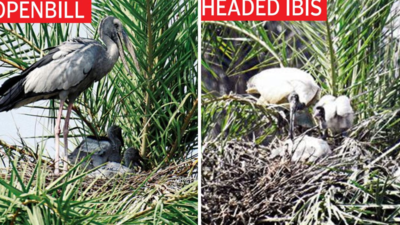- News
- City News
- noida News
- Fewer resident bird species breeding at Surajpur this monsoon
Fewer resident bird species breeding at Surajpur this monsoon

<p>Experts said this monsoon, the wetland has a small nesting colony with hardly 10-15 nests of five different bird species<br></p>
NOIDA: Fewer resident bird species are nesting and breeding at Surajpur wetland this monsoon, when their numbers usually multiply. Birdwatchers said the Oriental darter, black-headed ibis, Asian openbill, little cormorant, large egret, cattle egret, little egret, great egret, black-crowned night heron, grey heron, and purple heron are in the wetland now. However, they have found only the first five species nesting.
T K Roy, ecologist and conservationist, said this monsoon, the wetland has a small nesting colony with hardly 10-15 nests of the Oriental darter, black-headed ibis, Asian openbill, little cormorant, and large egret. “Every monsoon, at least ten species of resident water birds make their large, mixed nesting colony at the wetland. They usually make nearly 50 nests in total for successful breeding on the isolated date palms, safe from disturbances. But only five species have come up with a nesting colony this year,” he said.
He added that fewer water birds are nesting and breeding this monsoon due to unfavourable wetland habitats, most parts of which are chocked by water hyacinths. “The other issue is their numbers have decreased this year. Some of the birds may have shifted to other neighbouring wetlands,” he said.
Another birder, not wanting to be named, said that the number of birds and their breeding depend on the habitat. “The Surajpur wetland has a lot of water hyacinths and other aquatic weeds that need removing,” he said.
The Surajpur wetland is an urban wetland in the Yamuna river basin. It has 186 bird species belonging to 44 families, of which 102 are resident species, 53 are winter migrant species, 28 are summer migrant species, and three are passage migrant species, showed the wetland website. Roy said that WWF India recorded these 186 species from 2012-2013, but the present status is likely different.
District forest officer P K Srivastava said the department is undertaking several measures to make the environment conducive for birds. These include removing water hyacinths and other aquatic weeds, planting indigenous fruiting varieties, creating embankments and nature trails, and erecting fences in the outskirts and watch towers.
T K Roy, ecologist and conservationist, said this monsoon, the wetland has a small nesting colony with hardly 10-15 nests of the Oriental darter, black-headed ibis, Asian openbill, little cormorant, and large egret. “Every monsoon, at least ten species of resident water birds make their large, mixed nesting colony at the wetland. They usually make nearly 50 nests in total for successful breeding on the isolated date palms, safe from disturbances. But only five species have come up with a nesting colony this year,” he said.
He added that fewer water birds are nesting and breeding this monsoon due to unfavourable wetland habitats, most parts of which are chocked by water hyacinths. “The other issue is their numbers have decreased this year. Some of the birds may have shifted to other neighbouring wetlands,” he said.
Another birder, not wanting to be named, said that the number of birds and their breeding depend on the habitat. “The Surajpur wetland has a lot of water hyacinths and other aquatic weeds that need removing,” he said.
The Surajpur wetland is an urban wetland in the Yamuna river basin. It has 186 bird species belonging to 44 families, of which 102 are resident species, 53 are winter migrant species, 28 are summer migrant species, and three are passage migrant species, showed the wetland website. Roy said that WWF India recorded these 186 species from 2012-2013, but the present status is likely different.
District forest officer P K Srivastava said the department is undertaking several measures to make the environment conducive for birds. These include removing water hyacinths and other aquatic weeds, planting indigenous fruiting varieties, creating embankments and nature trails, and erecting fences in the outskirts and watch towers.
FOLLOW US ON SOCIAL MEDIA
FacebookTwitterInstagramKOO APPYOUTUBE
Start a Conversation
end of article









